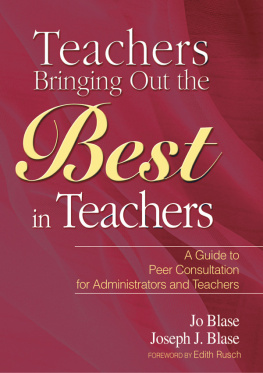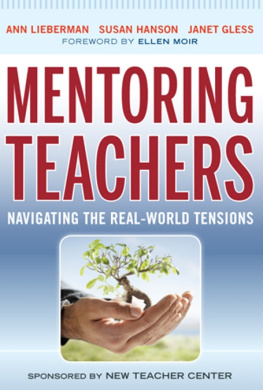To educational leadersboth teachers and administratorswho nurture a natural and powerful form of teacher growth: peer consultation
Copyright 2006 by Jo Blas and Joseph J. Blase
First Skyhorse Publishing edition 2014
All rights reserved. No part of this book may be reproduced in any manner without the express written consent of the publisher, except in the case of brief excerpts in critical reviews or articles. All inquiries should be addressed to Skyhorse Publishing, 307 West 36th Street, 11th Floor, New York, NY 10018.
Skyhorse Publishing books may be purchased in bulk at special discounts for sales promotion, corporate gifts, fund-raising, or educational purposes. Special editions can also be created to specifications. For details, contact the Special Sales Department, Skyhorse Publishing, 307 West 36th Street, 11th Floor, New York, NY 10018 or .
Skyhorse and Skyhorse Publishing are registered trademarks of Skyhorse Publishing, Inc., a Delaware corporation.
Visit our website at www.skyhorsepublishing.com.
10 9 8 7 6 5 4 3 2 1
Library of Congress Cataloging-in-Publication Data is available on file.
Cover design by Michael Dubowe
Print ISBN: 978-1-62914-669-0
Ebook ISBN: 978-1-63220-146-1
Printed in the United States of America
Contents
Foreword
S everal years ago, I introduced a new course into our leadership preparation program titled Leading the Learner Centered School. The content was predicated on the notion that teachers primary focus is on learners and learning. In my view, a deep understanding of that precept would assist aspiring school leaders to become more effective instructional leaders. A major assignment for students in this class was to partner with a learner of any age and spend the semester teaching each other about learning. The assignment culminated with a learning fair where each member of the class demonstrated the insights gained from the assigned consultation. I have fond memories of a music teacher bringing his partnersa quartet of sophomores who had taught him how capable they were at self-organizingto compose unique music. Their performance in our class was a unique culmination to our busy semester. Some students invited teaching partners and shared an action research process related to instructional decisions. Not everyone displayed live partners, but each demonstration paralleled the remarkable findings of the book you find in your handswhen individuals spend time together talking about learning, instruction changes, learners engage, and achievement improves. That is the core message of Jo and Joe Blase in Teachers Bringing Out the Best in Teachers.
This book ought to be required reading for every aspiring and practicing principal because it truly represents an enlightened conversation about instructional leadership. In this age of NCLB (No Child Left Behind), educational administrators at all levels of schooling are charged with being instructional leaders, yet the actual implementation of that concept remains a pretty contested notion. Some school administrators lead instruction through close supervision of highly prescribed classroom behaviors. Others lead by joining the Idea of the Month Club, overwhelming teachers with new approaches, new resources, and countless projects. Still others spend precious dollars on gurus who offer the latest fix for raising test scores. Study after study reports minimal gains in achievement from any of these approaches.
). Principals have the power to remove the barriers, either structural, organizational, or human. If we listen carefully to and reflect on the words of these peer consultants in our midst, the role of an instructional leader becomes crystal clear. Effective instructional leaders do one thing: organize an environment that supports teacher conversation about learning.
The Blases research makes visible the link between research-based knowledge and craft knowledge. Frequently, educators are cognizant of the research that touts positive learning outcomes of an innovative instructional approach. However, the actual implementation of the practice, the day-to-day organizing actions, may not be revealed in the research. Adult learners expect to master an idea very quickly; and if the experience of a new approach is messy for too long, they will give up on the practice despite research findings. The teacher voices in this book provide vivid descriptions of critical analyses and reflective work about daily practice in efforts to master new approaches. As they consult with peers, their craft knowledge clearly supports the adult learning curve.
This book challenges one other long-held assumption about teaching: that it is an isolated task. As I read the words of the many teachers in this study, I realized that despite the deep isolation of our organizational structures, teachers find multiple points of contact that break the isolation to hone their craft. In many cases, their informal talk fosters awareness of how easily classrooms become teacher centered rather than learner centered. One study participant noted how self-examination made me realize that. The students needs should come first ().
Clearly, I appreciate this new work by authors who have committed their professional lives to improving the experience of educating in our schools. I also am aware that many school leaders, who are committed to improving instruction, still struggle with the how of the work and resort to formal supervision and evaluation as a primary tool. This book provides more than a roadmap for the work of an instructional leader; the book itself is the journey. I encourage principals and teachers to use this book as a vehicle to foster faculty learning about learning. Each chapter contains powerful questions and implications for practice, as well as additional references that extend the topics. The most effective instructional leadership comes from principals who recognize and legitimize the natural tendency among educators to collaborate about learning. Used in this manner, school leaders may locate a new set of voices with rich data that will only improve our learner outcomes.
Edith Rusch
Associate Professor, University of Las Vegas
Preface
[T]he most reliable, useful, proximate, and professional help [ for teachers ] resides under the roof of the schoolhouse with the teaching staff itself.
Barth, 2001, p. 445
T his book is written for classroom teachers, lead teachers, teachers on special assignment, department chairpersons, principals, assistant principals, professional learning coordinators, and staff developers who want to promote teacher collegiality and school improvement by enabling teachers to collaborate on instructional matters. Uniquely, this book is not about formal professional development opportunities; rather, it is about naturally occurring, informal, spontaneous, timely, and relevant collaboration among teachers, that is, peer consultation . Peer consultation refers to two or more teachers engaging in dialogue about the idiosyncratic teaching context and individual teachers concerns. The focus of peer consultation is usually selected by the teacher who needs help, and peer consultants do not necessarily have expertise specific to a given teachers work. Thus, peer consultants are nonthreatening partners who facilitate a teachers reflection on teaching-learning issues, assessment of progress, and instructional improvement. The peer consultant is the unnoticed other who helps teachers blend scientific and craft knowledge in the complex, challenging, and often messy world of teaching and learning.










